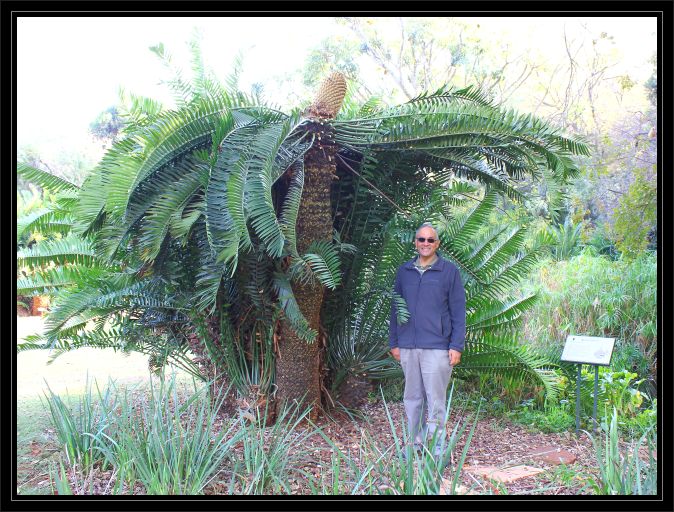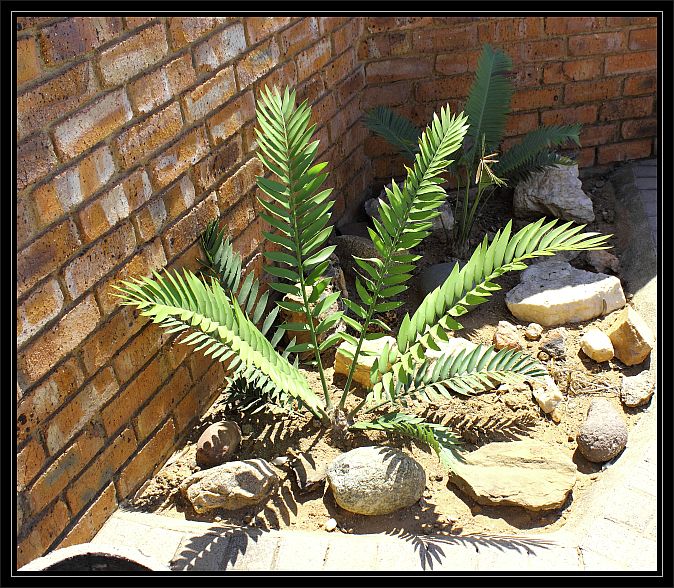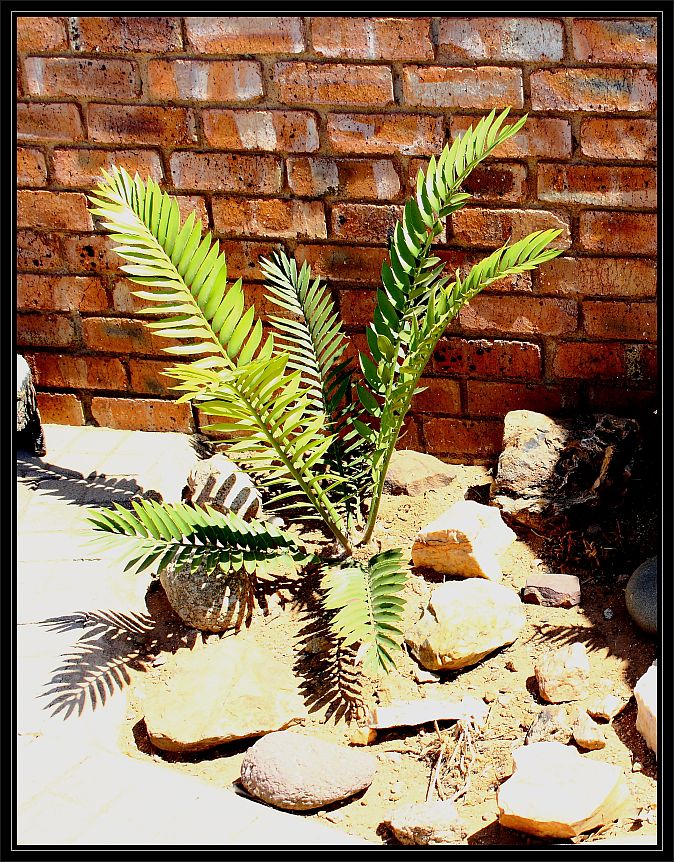Cycads have a long lifespan Toko. Some like the E.villosus live up to 60 years and others can live up to 1500 years.Toko wrote:

What is the lifespan of these amazing plants?
Cycads of South Africa
Moderator: Klipspringer
-
Sharifa
Re: Cycads of South Africa
-
Sharifa
Re: Cycads of South Africa
E. altensteinii
They are found all along the coastal area of the Eastern Cape and southern Kwazulu-Natal.
It is a medium to large plant growing up to 5m tall and the diameter of the stem 35cm. Suckers (new plants) are formed from the base of the main plant. All cycads are evergreen and the new leaves of the E. altensteinii are a bright green and turn yellowish green as they grow older. If grown in the shade the leaves could reach up to 2-3 m in length. In full sun the leaves tend to be slightly shorter. They produce new leaves in spring but not every year.
This one is growing in the Pretoria Botanical Gardens. The plant not Duke

This species is well known and common in private collections since it propagates easily and grows relatively fast. It is very robust and there exists a case of one plant lying in a shed for years and still grew vigorously after being replanted.
The E.altensteinii like all cycads is pollinated by insects and wind. The Knysna Loerie and the Trumpeter Hornbill are attracted to the bright red seeds in the disintegrating cones which are consumed by these birds. The fleshy layer is digested and the hard seed is regurgitated and this is also a way the seeds are dispersed.
It will still be many years before this one i my garden reaches the height of the one above


They are found all along the coastal area of the Eastern Cape and southern Kwazulu-Natal.
It is a medium to large plant growing up to 5m tall and the diameter of the stem 35cm. Suckers (new plants) are formed from the base of the main plant. All cycads are evergreen and the new leaves of the E. altensteinii are a bright green and turn yellowish green as they grow older. If grown in the shade the leaves could reach up to 2-3 m in length. In full sun the leaves tend to be slightly shorter. They produce new leaves in spring but not every year.
This one is growing in the Pretoria Botanical Gardens. The plant not Duke

This species is well known and common in private collections since it propagates easily and grows relatively fast. It is very robust and there exists a case of one plant lying in a shed for years and still grew vigorously after being replanted.
The E.altensteinii like all cycads is pollinated by insects and wind. The Knysna Loerie and the Trumpeter Hornbill are attracted to the bright red seeds in the disintegrating cones which are consumed by these birds. The fleshy layer is digested and the hard seed is regurgitated and this is also a way the seeds are dispersed.
It will still be many years before this one i my garden reaches the height of the one above


- Lisbeth
- Site Admin
- Posts: 65895
- Joined: Sat May 19, 2012 12:31 pm
- Country: Switzerland
- Location: Lugano
- Contact:
Re: Cycads of South Africa
"Education is the most powerful weapon which you can use to change the world." Nelson Mandela
The desire for equality must never exceed the demands of knowledge
The desire for equality must never exceed the demands of knowledge
-
Sharifa
Re: Cycads of South Africa
E.aplanatus

“E. aplanatus lacks aerial stems and has a mostly subterranean habit. Plants are solitary with an exposed apex. Branching or suckering does not occur.
The plant has few leaves, 2-6 normally, with occasionally 8 per plant. Young leaves are erect and arching but becomes almost horizontal with age. Young leaves are covered in fine hair but this is lost as the leaves get older.
Leaves can grow to 3.5m long with a petiole of 200mm.
Pollen cones number up to 3 per plant. They are up to 650mm long, 80mm to 100mm in diameter and the peduncle can be up to 220mm long. The male strobili emerge green but turn a pale yellow when mature. A female plant bears one or two cones. The cones appear in January, mid-summer, pollen is shed in mid-autumn and the female cones disintegrate in early to mid-spring. Seeds are ellipsoid, about 25mm long and 13mm to 15mm in diameter. The sarcotesta is bright red.
The species is endemic to, and occurs only in a small area in the north eastern part of Swaziland. It occurs in the shade of deciduous, fairly dry ravine forest. On a field expedition by the author of the taxon, only one colony was found and plants were scattered and not very healthy. Searching known localities where the species occurred in the 1940's also proved to be fruitless. It is possible that E. aplanatus was never abundant in the wild and to compound matters, the species has been collected to near extinction.

“E. aplanatus lacks aerial stems and has a mostly subterranean habit. Plants are solitary with an exposed apex. Branching or suckering does not occur.
The plant has few leaves, 2-6 normally, with occasionally 8 per plant. Young leaves are erect and arching but becomes almost horizontal with age. Young leaves are covered in fine hair but this is lost as the leaves get older.
Leaves can grow to 3.5m long with a petiole of 200mm.
Pollen cones number up to 3 per plant. They are up to 650mm long, 80mm to 100mm in diameter and the peduncle can be up to 220mm long. The male strobili emerge green but turn a pale yellow when mature. A female plant bears one or two cones. The cones appear in January, mid-summer, pollen is shed in mid-autumn and the female cones disintegrate in early to mid-spring. Seeds are ellipsoid, about 25mm long and 13mm to 15mm in diameter. The sarcotesta is bright red.
The species is endemic to, and occurs only in a small area in the north eastern part of Swaziland. It occurs in the shade of deciduous, fairly dry ravine forest. On a field expedition by the author of the taxon, only one colony was found and plants were scattered and not very healthy. Searching known localities where the species occurred in the 1940's also proved to be fruitless. It is possible that E. aplanatus was never abundant in the wild and to compound matters, the species has been collected to near extinction.
- Lisbeth
- Site Admin
- Posts: 65895
- Joined: Sat May 19, 2012 12:31 pm
- Country: Switzerland
- Location: Lugano
- Contact:
Re: Cycads of South Africa
They are beautiful and interesting plants, but they all look more or less alike to me  Maybe live it is easier to see the difference
Maybe live it is easier to see the difference 

"Education is the most powerful weapon which you can use to change the world." Nelson Mandela
The desire for equality must never exceed the demands of knowledge
The desire for equality must never exceed the demands of knowledge
Re: Cycads of South Africa
This topic needs more study, thanks Sharifa.
One of my happiest moments in my garden was when I successfully get some seed (Lebombohensis ) to grow.
One of my happiest moments in my garden was when I successfully get some seed (Lebombohensis ) to grow.
Stop buying frackers products,now !!!
Biyamiti camp-Nov 2017- with family and friends
Biyamiti camp-Nov 2017- with family and friends
-
Sharifa
Re: Cycads of South Africa
There are some that are easy to recognise Lisbeth. There are some with blue leaves like the E. eugene maraisii I mentioned first up, and then others with soft, thin green leaves. I will get to those soonLisbeth wrote:They are beautiful and interesting plants, but they all look more or less alike to meMaybe live it is easier to see the difference

With the green leafed cycads it is more difficult but there are subtle differences. Some are differentiated by the shape, size and colour of the leaves.
Did you germinate the seeds Dup?dup wrote:This topic needs more study, thanks Sharifa.
One of my happiest moments in my garden was when I successfully get some seed (Lebombohensis ) to grow.
I am trying for the first time with the eugene maraisii and it is a long process but hopefully I succeed. I am trying to get as much info as I can.


